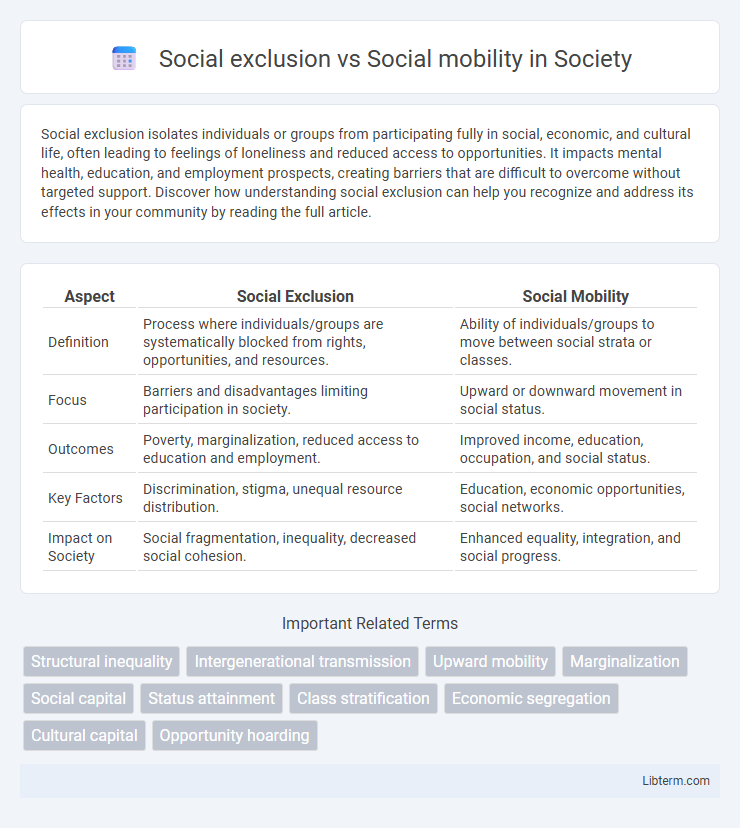Social exclusion isolates individuals or groups from participating fully in social, economic, and cultural life, often leading to feelings of loneliness and reduced access to opportunities. It impacts mental health, education, and employment prospects, creating barriers that are difficult to overcome without targeted support. Discover how understanding social exclusion can help you recognize and address its effects in your community by reading the full article.
Table of Comparison
| Aspect | Social Exclusion | Social Mobility |
|---|---|---|
| Definition | Process where individuals/groups are systematically blocked from rights, opportunities, and resources. | Ability of individuals/groups to move between social strata or classes. |
| Focus | Barriers and disadvantages limiting participation in society. | Upward or downward movement in social status. |
| Outcomes | Poverty, marginalization, reduced access to education and employment. | Improved income, education, occupation, and social status. |
| Key Factors | Discrimination, stigma, unequal resource distribution. | Education, economic opportunities, social networks. |
| Impact on Society | Social fragmentation, inequality, decreased social cohesion. | Enhanced equality, integration, and social progress. |
Understanding Social Exclusion: Definition and Causes
Social exclusion refers to the process by which individuals or groups are systematically blocked from rights, opportunities, and resources that are normally available to members of society, leading to social isolation and economic disadvantage. Causes of social exclusion include poverty, discrimination based on race, gender, or ethnicity, lack of access to education and employment, and geographic segregation. Understanding these factors is crucial for addressing social inequalities and promoting inclusive social mobility.
What Is Social Mobility? Key Concepts Explained
Social mobility refers to the ability of individuals or groups to move within a social hierarchy, often measured by changes in income, education, or occupational status across generations. Key concepts include intergenerational mobility, which tracks movement between parent and child generations, and intragenerational mobility, which examines changes within an individual's lifetime. Social mobility is a critical indicator of equality of opportunity and affects economic growth, social cohesion, and individual well-being.
Comparing Social Exclusion and Social Mobility
Social exclusion restricts individuals or groups from participating fully in social, economic, and political life, often resulting in limited access to resources, education, and employment opportunities. In contrast, social mobility refers to the ability of individuals or families to improve their social status, typically measured through changes in income, education, or occupational prestige across generations. While social exclusion perpetuates inequality and systemic barriers, social mobility reflects the potential for breaking these barriers and achieving upward economic and social progression.
Historical Context: Evolution of Social Structures
Social exclusion and social mobility have evolved through complex historical shifts in social structures, where rigid class systems in feudal and industrial societies limited upward movement and perpetuated exclusion. The Industrial Revolution marked a turning point by creating new economic opportunities that altered traditional hierarchies, yet barriers based on race, gender, and economic background continued to enforce social exclusion. Modern welfare states and policy reforms aim to enhance social mobility by dismantling systemic inequalities, although historical legacies still influence patterns of exclusion today.
Barriers to Social Mobility: Factors and Impacts
Barriers to social mobility include unequal access to quality education, limited economic opportunities, and systemic discrimination based on race, gender, or socioeconomic status. These factors perpetuate social exclusion by restricting individuals' ability to improve their social and economic standing, reinforcing cycles of poverty and marginalization. The impacts of these barriers manifest in reduced social cohesion, increased inequality, and diminished overall economic growth.
How Social Exclusion Perpetuates Inequality
Social exclusion limits access to education, employment, and healthcare, reinforcing systemic barriers that prevent disadvantaged groups from advancing economically and socially. This persistent marginalization undermines social mobility by restricting opportunities for upward movement and concentrating poverty within specific communities. Structural discrimination and unequal resource distribution further entrench inequality, creating intergenerational cycles of disadvantage.
Policies Addressing Social Exclusion and Mobility
Policies addressing social exclusion prioritize inclusive education, affordable housing, and anti-discrimination laws to integrate marginalized groups into mainstream society. Social mobility policies focus on equal access to quality education, skills training, and fair labor market opportunities to enable upward economic and social advancement. Targeted welfare programs and affirmative action initiatives are crucial in reducing barriers and fostering both social inclusion and mobility.
Case Studies: Real-World Examples and Lessons
Case studies from diverse regions illustrate stark contrasts between social exclusion and social mobility; for instance, urban slums in Mumbai demonstrate entrenched social exclusion through limited access to education, healthcare, and employment, whereas programs like Brazil's Bolsa Familia highlight pathways to social mobility by providing conditional cash transfers that incentivize school attendance and health check-ups. Evidence from Scandinavian countries shows that robust social welfare systems and inclusive policies contribute to high social mobility by reducing income inequality and providing equal opportunities. Lessons from these examples emphasize the critical role of targeted interventions, inclusive education, and community engagement in breaking the cycle of social exclusion and fostering upward mobility.
The Role of Education in Overcoming Social Exclusion
Education serves as a critical tool in overcoming social exclusion by providing marginalized groups with access to knowledge, skills, and opportunities that facilitate social mobility. Quality education reduces inequalities by empowering individuals to break cycles of poverty and discrimination, enhancing employability, and promoting civic participation. Investment in inclusive educational policies and programs is essential to dismantle structural barriers and create pathways for upward social movement.
Strategies for Promoting Inclusive Social Mobility
Strategies for promoting inclusive social mobility emphasize equitable access to quality education, affordable healthcare, and employment opportunities tailored to marginalized communities. Implementing targeted social policies such as affirmative action, skill development programs, and social safety nets reduces barriers created by social exclusion and fosters economic participation. Strengthening community networks and inclusive governance enhances social capital, enabling upward mobility across diverse socio-economic groups.
Social exclusion Infographic

 libterm.com
libterm.com